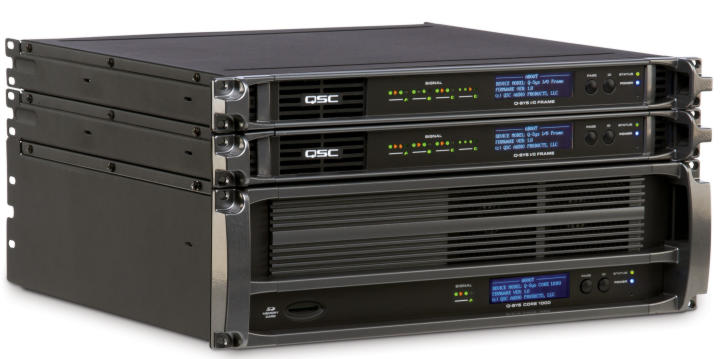| Pro-Music-News™ | Installed Sound |
| Index Installed Sound | Main Index English | Search Site |
Q-Sys DSP platform provides high-speed setup of large audio systems
| QSC unveiled its new Q-Sys DSP platform to the industry at large for the first time at InfoComm 2009 in Orlando, Florida, booth #6443. Comprehensive and intuitive, Q-Sys takes a step forward within the realm of DSP and integration, providing digital audio signal routing and processing technology combined with complete system monitoring and control. Q-Sys is designed to easily meet the needs of applications ranging from the largest imaginable to those much smaller in scope and allotted budget. “From concept to finished product, Q-Sys was developed every step of the way by some of the brightest minds in professional audio,” said QSC Director of Marketing Evan McKenzie. “Known for their development of CobraNet and other groundbreaking products and technologies, the team of engineers from Peak Audio in Boulder, Colorado joined QSC in 2006, and have been working since that time alongside engineers from QSC’s System Development Group in Costa Mesa, California to re-architect system integration and bring Q-Sys to life.” “This platform is incredible,” says QSC’s Q-Sys Product Manager Dale Sandberg. “It provides an unrivalled amount of integration capability and processing power. A system of almost any size can be designed from microphone, line-level, or digital input all the way to amplifier or loudspeaker output without requiring any sub-segmentation due to processor constraints. While it supports the use of third party control products, it is designed to enable whole system control and monitoring without additional products or applications. At the same time, it’s simpler and easier to use than any other audio package I’ve ever seen.” Using premium converters and Gigabit Ethernet, the fundamental Q-Sys architecture produces a total system latency of less than 2.5 milliseconds between any input and output, with up to ten network switch hops and audiophile quality processing throughout. Central to the system's inner strength is the Q-Sys Core processing engine. Available in three sizes ranging from 64 inputs x 64 outputs to 256 inputs x 256 outputs, the Q-Sys Core works in tandem with Q-Sys I/O Frames: 1 RU modules that accommodate up to 16 channels of audio using factory-configured, four-channel Q-Sys cards supplying a variety of input and output options. The use of AES cards can permit up to 32 channels of audio in a single Q-Sys Node. Just like the Q-Sys Core, I/O Frames are equipped with dual Ethernet ports to support network and system redundancy. Select the appropriate output cards, and Q-Sys is compatible with any analogue-input power amplifier or powered loudspeaker. The full power and potential of a Q-Sys system is best realised when QSC Dataport amplifiers and loudspeakers are inherent within the design. To use a QSC line array, for example, use the Q-Sys design GUI to virtually connect it to QSC amplifiers, and Q-Sys automatically provides the proper Intrinsic Correction tuning. Any input can be routed to any output without the need for creating convoluted signal paths. The need for system segmentation due to processor constraint is completely eliminated as well, thereby letting the designer create a ‘natural’ signal flow based on the job not the product. With the aid of Q-Sys Designer — software that can be used online or offline — virtually any audio component or function is made available. Parameters including channel count, frequency bands, and much more can be easily scaled on the fly, while control panels can be built simply by dragging the controls and indicators from processing objects to a control panel editor. When completed, the Q-Sys Core will publish the control panels to any browser-capable device. Q-Sys also supports the use of third-party control devices like those from AMX or Crestron using a TCP/IP-based control protocol. As the industry has come to expect from everything in the QSC catalogue, rugged reliability is a steadfast ingredient of the Q-Sys platform design. An audio system falling under Q-Sys guidance and monitoring additionally gains the benefit of a host of onboard test and measurement functions, and is quicker to set up and commission as well. Q-Sys configurations can be compiled within seconds. Audio designers can now readily optimise their systems in little to no time instead of the 10 to 30 minutes they used to know as the norm. |
 |